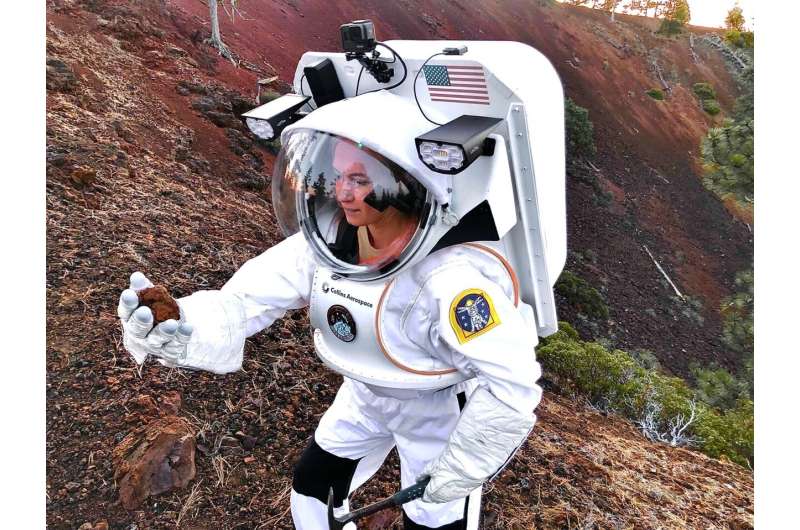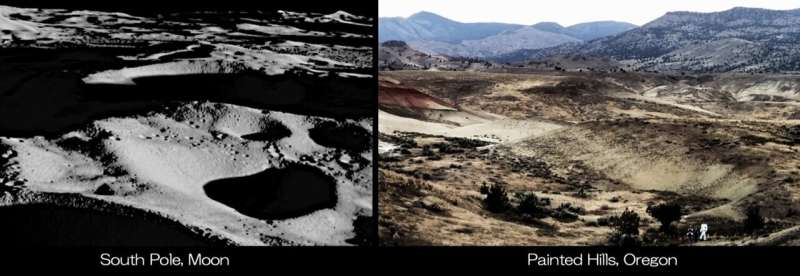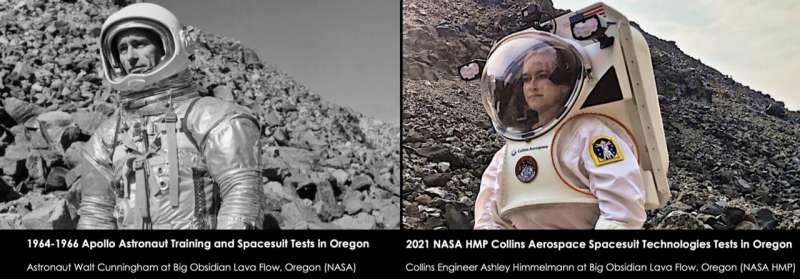The NASA Haughton-Mars Project (HMP) and collaborating organizations SETI Institute, Mars Institute, Collins Aerospace, and Ntention are announcing the successful field testing of new spacesuit technologies for future astronaut science and exploration operations on the Moon and Mars.
The field tests were conducted in Oregon's High Desert region, at the same sites once used by Apollo astronauts to train and test spacesuits in preparation for their historic journeys to the Moon. Several new sites also considered relevant for future Moon and Mars exploration in hindsight of the lessons from Apollo and from recent robotic missions to the Moon and Mars, were also visited.
"It was exciting to be in Oregon to revisit some of the very locations where, in 1964 and 1966, the Apollo astronauts received field training in geology and tested spacesuits," said Dr. Pascal Lee, a planetary scientist with the SETI Institute and the Mars Institute, and director of the NASA Haughton-Mars Project at NASA Ames Research Center. "We have also identified new candidate sites for Moon and Mars exploration preparation, now that we know more, compared to the mid-60s, about the Moon and Mars."
The sites visited by the NASA Haughton-Mars Project team included the main Apollo legacy training and spacesuit test sites in Oregon: Lava Butte, Big Obsidian Lava Flow, Fort Rock, Hole in the Ground, and Yapoah Lava Flow at McKenzie Pass. New sites visited in preparation for exploring the Moon's south polar highlands and lunar caves, and eventually Mars, included Pumice Slope at Crater Lake National Park, the Painted Hills at John Day Fossil Beds National Monument, and Skylight Cave, a lava tube with multiple roof collapse openings. The sites were accessed with support from the United States Forestry Service Deschutes National Forest and the National Park Service.

NASA's current Artemis Program aims to land the first woman and next man on the Moon, near the lunar South Pole, by the end of this decade and build on this experience to eventually send humans to Mars. In anticipation of the science and exploration needs of future Moon and Mars astronauts, several new technologies are undergoing development and testing to help optimize the safety, productivity, and cost-effectiveness of future EVAs (Extra-Vehicular Activities) or spacewalks.
Central to the week's field tests was Collins Aerospace's innovative, integrated Information Technologies and Informatics Subsystem (IT IS). Currently, astronauts on spacewalks rely on spiral-bound notebooks attached to their elbows to flip through checklists. The Collins IT IS allows astronauts to autonomously track these checklists and act upon the status of their health and that of their EVA companions (vital signs, exertion levels) through a display system in their helmets. They can also monitor the performance of a wide range of EVA systems—power, oxygen, water reserves—the astronauts' location, EVA elapsed time, EVA time remaining, and range from supplies. The IT IS also displays maps and a wide array of other data supporting astronaut science and exploration activities, such as imaging, note-taking, and sample management.
"We see the integration of our Information Technologies and Informatics Subsystem into a spacesuit as a game-changer for conducting EVAs," says Greg Quinn, lead for advanced spacesuit development at Collins Aerospace. "The Collins IT IS will help enhance the autonomy, productivity, and safety of future explorers."
"While real-time mission support from Earth will remain important, exploring the lunar poles, where NASA intends to land Artemis astronauts, means that direct-to-earth communications will not, at times, be possible, even via orbital relays. So we need to provide future lunar explorers with the means to safely perform more autonomous EVAs," explains Lee. "The need for autonomy will be further compounded in the case of Mars, where communications delays will drastically limit real-time mission support from Earth."

Field tests in Oregon began at dawn hours each morning to take advantage of grazing solar illumination in anticipation of challenging lighting conditions at the lunar South Pole. The field sites accessed offered a wide range of terrain roughness, slopes, topographic complexity, and scales of operation anticipated during future EVAs in the lunar South Pole region. EVA systems requirements for future lunar pit and cave exploration were also investigated, a first for a spacesuit manufacturer.
One of the field campaign's key achievements was successfully integrating the Norwegian company Ntention's innovative Astronaut Smart Glove (ASG) system with Collins Aerospace's IT IS. The ASG is an advanced human-machine interface (HMI) integrated into the spacesuit helmet and glove. It allows an astronaut to remotely operate a wide range of possible robotic assets such as robotic arms, cranes, rovers, and even drones, with minimal hand gestures compatible with wearing a constricting and rigid pressurized spacesuit. The ASG field test demonstrated the successful collection of rock sample materials from remote locations not directly accessible to the astronaut.
"Our field test this year demonstrated how an HMI like our Astronaut Smart Glove system can be seamlessly integrated into a spacesuit and offer future astronauts on the Moon and Mars much greater perception, reach, and control of their surroundings," said Moina Tamuly, Co-CEO and Co-Founder of Ntention.
"By coming to Oregon, we wanted to recapture Apollo's historic legacy, but also scout out new experiences for future astronaut training and spacesuit testing as we take on this century's new challenges, the lunar poles and Mars," said Lee. "I'm excited to report that we did catch a glimpse of this exciting future this week."



